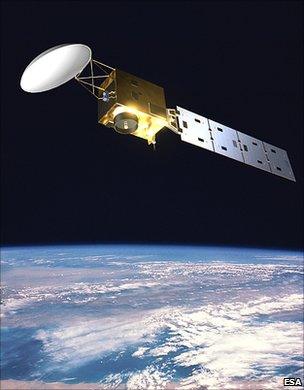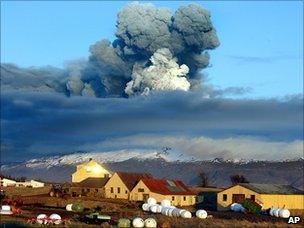Costly Euro space laser reviewed
- Published

Europe's Earthcare satellite is unlikely now to get into space before 2016
European scientists are being asked whether they still want to go ahead with a pioneering space laser mission.
The Earthcare satellite would study the role clouds and atmospheric particles play in a changing climate.
But difficulties in developing the spacecraft's lidar instrument mean the cost of the venture will likely rise from 450m to 590m euros (£500m).
A review is therefore taking place to assess the science value and technical risks of proceeding.
"European Space Agency (Esa) member states have asked us to bring together all the pros and cons in this formal review," said Dr Volker Liebig, Esa's director of Earth observation.
"They want us to speak to the scientists, to look into whether there are any alternatives which lead to the same scientific results. We will then take the conclusions of this review to the member states so they can decide what to do," he told BBC News.
Earthcare was chosen to be one of Esa's Earth Explorers - a series of spacecraft that will do innovative science in obtaining data on issues of pressing environmental concern.
Three missions have so far gone into orbit, returning remarkable new information on gravity, polar ice cover, soil moisture and ocean salinity.
Earthcare is in line to be the sixth Explorer. It would study how clouds and aerosols (fine particles) form, evolve and affect our climate, the weather and air quality.
Scientists say knowledge gaps in such areas severely hamper their ability to forecast future change.
Different sorts of cloud have different effects. For example, low cloud can help cool the planet while high cloud can act as a blanket.
Developing the primary instrument on Earthcare to get at this information has proved extremely problematic, however.
The intention is to use a lidar, which would fire pulses of ultraviolet light down into the atmosphere.
From the way this light is scattered back to the spacecraft, scientists would be able to build up a picture of where in the atmosphere different cloud types and aerosols reside, and work out their impact on the energy budget of the Earth.
But the instrument's prime contractor, EADS Astrium SAS (Toulouse), has had a torrid time arriving at a design that would reliably work in the vacuum of space.
In tests, engineers found the instrument would contaminate itself with molecular deposits released from the mechanism's own materials whenever they ran the laser in conditions similar to those expected in orbit.
"It was only happening when we operated it in a vacuum," explained Dr Liebig.
"We've had to organise a lot of research but we now understand what happens. It led to the decision that we should go from a monostatic laser which means you have the transmitting and receiving parts in one, to a bi-static laser which divides the two. On top of that, we pressurise the laser. This is a big change."
The final preferred configuration has delayed Earthcare's progress and added significantly (140m euros) to the projected total mission cost.
It is unlikely now that Earthcare can get into orbit before 2016 - two years later than recent estimates.
Some of the extra cost - about two-thirds - is a result of the additional investment required to build the lidar in the new configuration, but part of the inflation - about one-third - is a consequence of having to use a more powerful rocket to launch what will now be a bigger and heavier satellite.

Climate modellers need more information on clouds
Earthcare will require the more expensive Soyuz vehicle rather than the less expensive Vega rocket.
Esa's Earth observation programme board has asked for a review of the Earthcare project.
The agency's member states want to establish the technical risks of moving ahead with the mission.
They want to know that costs will not go on climbing; and they also want reassurance that the promised advances in scientific knowledge can still be delivered by the satellite.
Professor Anthony Illingworth from Reading University, UK, is the European chair of the panel of scientists that advises Esa on the Earthcare mission.
He told BBC News that there was still a huge amount of knowledge to be gained from flying a space lidar.
"When we look at climate models, the principal cause of uncertainty is the clouds," he said.

Iceland's Eyjafjallajokull eruption emphasised the need for lidar technology
"There is a big, what we call, 'forcing effect' from high and low-levels clouds, and at the moment they almost cancel out - the effect of the clouds on the Earth is a slight cooling. But of course in a future climate, if the balance of high and low-level clouds changes - which is why Earthcare is important because it would tell you where the clouds are - and you get more high-level clouds then that would warm the Earth up even more."
The scientific case has also been bolstered in the past year by the Eyjafjallajokull eruption in Iceland, which led to economic losses across the EU put at many hundreds of millions euros. One of the most valuable datasets in determining the precise distribution of the volcanic plume came from the lidar on the US Calipso satellite. Earthcare could undoubtedly make a similar contribution if such conditions were ever repeated.
Like all Esa missions, the Earth Explorer is a pan-European effort.
Industrially, it is managed by the German section of EADS Astrium (Friedrichshafen), but significant parts of the spacecraft are being fabricated in the UK.
These include the main structure of the satellite at Astrium UK (Stevenage), and two additional instruments, at SSTL (Guildford) and SEA Group Ltd (Frome).
A fourth instrument, a cloud profiling radar, is being supplied by the Japanese Space Agency (Jaxa).
Esa member state delegations will meet to discuss the Earthcare review most likely at the end of March.
- Published17 January 2011
- Published21 December 2010
- Published17 December 2010